A Scion Society of The Baker Street Irregulars
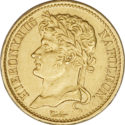
The Westphalian Coinage of Jerome I
“… the natural anxiety of a wife for her missing husband.”
– The Sign of The Four (SIGN)
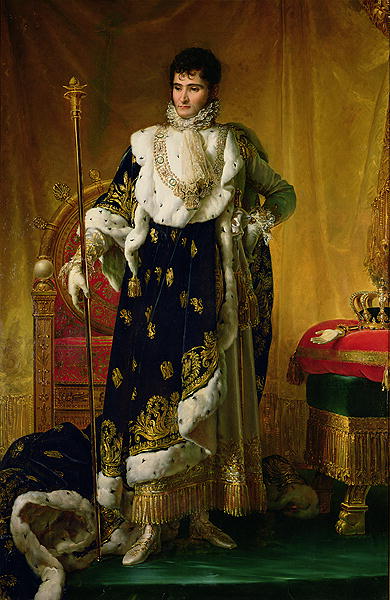
Jérôme-Napoléon Bonaparte was the youngest brother of Napoleon Bonaparte, a military leader who would become the Emperor of France. In his late teens, Jerome visited the United States after serving in the French navy in the Carribean.

While visiting the United States, Jerome met Elizabeth “Betsy” Patterson of Baltimore. At the turn of the 18th century, Baltimore was the largest city in the county and Patterson’s father was the second richest man in Maryland. The would fall in love and the 19 year old Jerome and the 18 year old Betsy would be married on December 24, 1803 by the Archbishop of Baltimore, John Carroll. This occurs five months before Napoleon declares himself as the Emperor of France.
The soon to be Emperor was furious and ordered his younger brother to return without his new wife. Jerome and the now pregnant Betsy would set sail for France in the fall of 1804, but not in time for Napoleon’s coronation ceremony. Betsy was not allowed to leave the ship and step foot on the European continent by order of the Emperor. Jerome would go off to Italy to plead their case to his brother. The two would never see each other again. Jerome was told he must give up Elizabeth or be stripped of all his titles and left without a cent. Despite his proclamations of love, he followed his brother’s orders. Betsy would give birth to their son, Jerome Napoleon Bonaparte on July 7, 1805 in London.
The Emperor would appeal to Pope Pius VII to annul Jerome’s wedding to Betsy, but the Pontiff refused to do so. Napoleon would annul the wedding himself, by decree on March 11, 1805. Napoleon would install Jerome as the King of Westphalia, which was carved out of various German territories, on July 8, 1807. Jerome would marry Princess Catharina Frederica of Württemberg on August 22, 1807. They would rule Westphalia until October of 1813, after Napoleon had been defeated at the Battle of Leipzig.
Betsy and her son would return to Baltimore. In 1815, the state legislature of Maryland would pass an act that granted Betsy a divorce from Jerome. She would spend the rest of her life trying to secure the imperial title for herself and her son. She was able to secure for herself a annuity from the French government.
With this history in mind, the six gentlemen who met on September 11, 1946 to form a Baltimore scion of the Baker Street Irregulars, chose to name themselves The Six Napoleons of Baltimore.
King Jerome I’s (formally Hieronymus Napoleon) short reign did produce a number of various coin designs. Let’s take a look at a few of them.
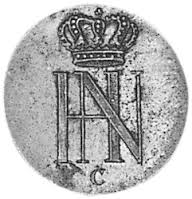
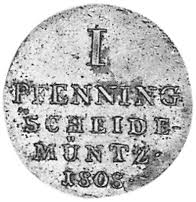 The minor coinage featured the monogram of Hieronymus Napoleon on the obverse and the denominations on the reverse. The 1 pfennig and 2 pfennig coins were of copper, while the 4 pfenning and mariengroschen (1/36 thaler) were struck in billon. The 1/6 thaler coins were in silver.
The minor coinage featured the monogram of Hieronymus Napoleon on the obverse and the denominations on the reverse. The 1 pfennig and 2 pfennig coins were of copper, while the 4 pfenning and mariengroschen (1/36 thaler) were struck in billon. The 1/6 thaler coins were in silver.

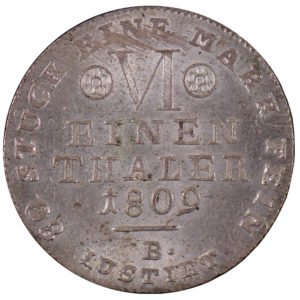
The crowned arms of Westphalia replaces the monogram on some of the 1/6 thalers and thalers, both in silver. It is also used on gold 5 and 10 thaler coins.


Jerome I faces to the right on these silver 2/3 thaler and 1 thaler coins.
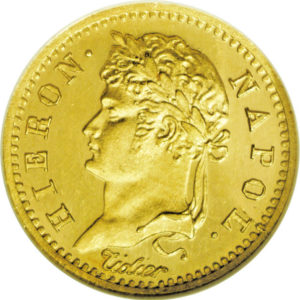
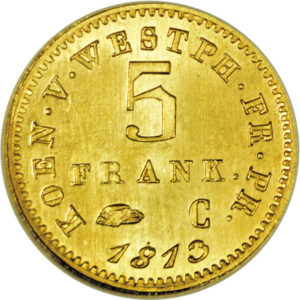
However, Jerome I faces to the left on all of his gold coins.
For those curious about what parts of Germany made up Westphalia, the following map might be of interest.
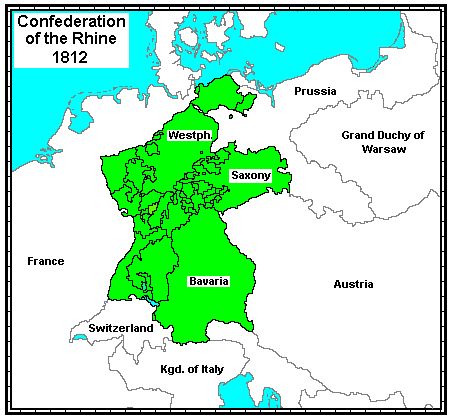

Sorry, comments are closed for this post.